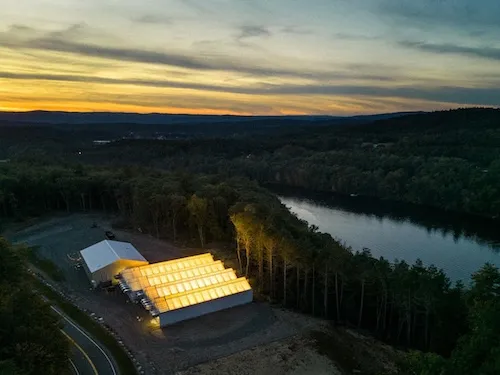Pioneer Valley grower puts sustainability first with energy-efficient hybrid greenhouses

Sustainability above all
The key aspect of Picnic’s greenhouses is that they leverage natural resources, such as sunlight, as much as possible and only supplemental lighting when necessary. That is why, for instance, they have PAR sensors to manage their lights so they turn off when there’s enough sunlight, as well as vents that open to let outside air in, or black out tarps to manipulate the growing times and prevent light pollution. Amy Hopkinson, the head grower at Picnic, has experience in indoor cultivation; however, she points out that controlling the environment in the greenhouse is a much more dynamic exercise. “Simply because you have to be much more in tune with the outside climate,” she says. “Indoor facilities are more of a solidified structure with more stable controls, and it’s great when your whole environment is perfect. But if things go sideways, it’s much harder to put things back on the right track.”
Another important aspect of Picnic’s sustainability effort is how they handle waste. Ezra says that many growers tend to throw compostable materials, such as used growing media, stems, leaves, and the like, in the trash. “Many growers put organic biomass in the trash. With all the waste a farm generates, there are huge amounts of trash that could be easily composted. That is why we send all of our organic waste to a composting facility in the next town. There are so many ways you can reduce your environmental footprint, and composting is a huge one.”
Precision planning, data analysis, and cultivation
Obviously, the success of Picnic’s cultivation is based on meticulous planning, and Amy is particularly good at that, Ezra points out. “Once we got through our first year, we did a lot of prep work, took lots of notes, and analyzed a large amount of data. Now that we’re nearing the end of our second winter, we are now in a good spot. We’ve seen each of the seasons, and we are rolling with the punches.” The first seed in Picnic’s greenhouses was planted in May 2023, with the first harvest coming in September 2023. The approval to enter the market arrived later in the fall. “It took a lot to go through each of those seasons to see how the equipment would perform, how our strains performed, and we got increasingly confident every month.”
One of the main challenges for growers is pests and pathogens, and this is especially true if you grow in a greenhouse, where you are potentially more exposed to such threats. “We are dealing with a breathing facility here,” says Ezra. That’s because, while it is true that outside air comes in, intake fans have filters that keep mold and bugs at bay. The facility is designed to have the air move from one end to another with to minimize biohazard risk. “We haven’t had to deal with any infestation of any kind,” Amy says. “The most common pests and pathogens are your usual suspects: aphids, botrytis, powdery mildew, and so on.” As expected from a company that values sustainability, no chemical sprays are used to battle pests. Rather, beneficial insects live and fly throughout the facility, fighting off any unwanted guests. “Of course, a lot of controlling potential bugs and diseases falls on managing temperature and humidity properly so that plants are in a safe environment. Next to that, we have a variety of bug friends that keep things nice for us.”
It’s also important to have cultivars that perform at their best in such a unique setup. “We started off with just seeds,” says Amy. “When we started, we did a massive pheno hunt. We had 25 different strains for a total of 330 phenos. We thought, let’s see what we’ve got here. But we also have some great partners who value hash production, so we brought in third-party genetics that are well known to be strong producers for hash production. We need plants that produce a lot of trichomes.”
Specialization
That is because Picnic doesn’t sell flowers only—or rather, that is just a small part of the business. The company is mainly focused on producing fresh frozen cannabis which is turned into rosin by solventless extraction. This is a strategy Ezra had in mind since the company’s inception, as he was very much aware of the state of the market and the stories of large companies that wanted to do too much, too quickly. “Although there has been an oversupply for a long time, there are still $1.5B+ in sales every year. If you practice sound business fundamentals, create high-quality products, and take care of your team, there are still opportunities out there.” And the key, according to Ezra, is also specialization. “Think of Toyota, for instance. They don’t make the fabric for the seats of their cars. Rather, they buy it from a third party. We set out to focus on one thing only—namely, fresh frozen—and be really good at it. We are starting to see some specialization in the market, which, for me, is a signal that the market is maturing.”
Specializing in one thing also means being aware of market trends, and Amy and Ezra are very much in tune with what customers are seeking. “As a grower, you have to speak to those trends. Currently, many are prioritizing potency. However, others are looking for something that doesn’t give them a panic attack, so to speak. I’m hopeful that in the near future, we’ll see a shift in popularity, with richer cannabis experiences rather than a sole focus on THC content.” For Ezra, a self-described foodie, it is also important to know how a product is grown and the practices of the company producing it. “I care about the origin of my food and how it’s produced. The same goes for cannabis. It’s important to support small, independently owned businesses that do things differently with a special type of care.”
Expansion, more products, same sustainability
As Picnic continues to grow, Ezra envisions expanding the number of their greenhouses by two, with sustainability as the guiding principle. “For now, this year, our priority is to bring our consumer-facing brand, Picnic, to the market with prerolls and packaged flower. We are spending a lot of time researching the right type of packaging because, needless to say, it needs to be sustainable.” Amy, too, looks forward to more greenhouses coming online in the Pioneer Valley. “If we get more greenhouses, my plan is to fill them up as fast as I can,” she says with a chuckle.
 717-703-0804
717-703-0804